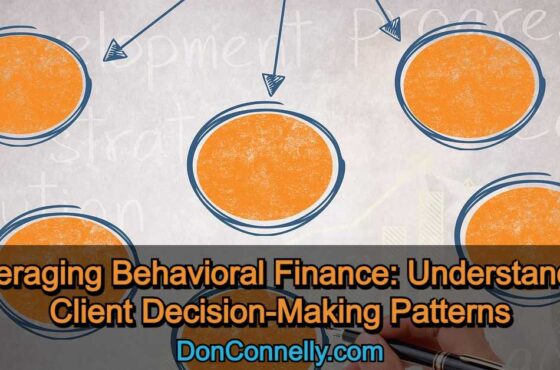How Financial Advisors Should Manage Emotional Clients
 People aren’t rational. We’re all creatures of emotion. Good salespeople bear that in mind. Whatever your training and education, as financial advisors, we’re not engineers. We’re not technicians. Not in the sales interview.
People aren’t rational. We’re all creatures of emotion. Good salespeople bear that in mind. Whatever your training and education, as financial advisors, we’re not engineers. We’re not technicians. Not in the sales interview.
We deal with people first. Not numbers. Not machines.
Advisors who understand this are going to do better than advisors who don’t.
Kirk got more girls than Spock.
So, when you’re in a selling situation against tough competition, the prospect isn’t going to go with the one with the most detailed spreadsheet. The prospect is going to go with the one that makes them feel better.
Think vs. ‘Feel’
That brings up one of my favorite trial closes. During selling situations, ask a prospect “what do you think about X?” That activates their natural skepticism and defensive mechanisms, which you then have to overcome before you can land a sale.
Instead, I always ask “how do you feel about X?”
But sometimes I want to help them see past their emotions, and help them achieve a more rational headspace, so they can make better financial decisions.
The process boils down to this:
- Plant the seeds for rational decision-making before the crisis happens.
- Let them know you understand what they’re going through.
- Diffuse the negative emotions, whatever they may be, and help the client see past them.
- Encourage and reinforce rational thought processes.
- Help them make rational buy and sell decisions.
Let’s take a closer look at some common circumstances nearly all advisors encounter sooner or later.
Dealing with a bear market
Bear markets happen – and you’ve got to have a plan for dealing with them.
The best plan is to prepare your clients for that near certainty in advance:
“Mr. and Mrs. Client, I hope to be working with you for a long time – and with your families for many years to come. You’ve chosen to assume some market risk here, because stocks are a great long-term investment over time.
But in the short run, as we both know, you could be taking some short-term losses.
If we work together for a long time, it’s a near certainty that sooner or later, there’s going to be a big market correction, and maybe even a stock market crash. So I want you to be psychologically prepared for that, right?”
And then you show them, before the crisis comes to pass, that stock market declines have always been temporary, and that stocks generally go on sale during major bear markets. The idea is to get them to agree that the strategy going forward should be:
- Don’t panic.
- Stay the course.
- Buy low, sell high.
- Focus on the long-term strategy.
Fast forward to the market crash. You’re going to hear from a lot of your clients. And they aren’t always going to be rational about it! The rational ones will be the ones putting in ‘buy’ orders. And you’ll have a few of them. But when the bears are dominating, most of your calls are probably going to come from people who are in a state of fear or panic.
You can help them see the light. But not while they’re frightened out of their wits. They won’t be listening to logic at that point. So the first task is to diffuse and redirect. That is, you must loosen the grip that fear has on them so you can focus their attention not on their short-term fears, but on their long-term financial health.
The power of “I understand.”
First, you have to let them know that you completely understand what they’re going through. That helps you get on their side of the table. If they believe that you understand their fears, they will be more inclined to trust you. Which is a necessary precondition for moving forward, because if they don’t trust you at the emotional, visceral level, they aren’t likely to listen to your advice.
Only once you’ve regained a sufficient amount of trust will they be receptive to your real message: Don’t panic. Stay the course. Stay focused on the long-term strategy. And buy low, sell high.
Help them say it in their own words.
Now that you’ve calmed them down a little bit, you can help them remember a time when they weren’t so fearful – when you discussed ahead of time what the plan would be during a market sell-off:
“Remember when we first started working together… we talked about this very thing: What we would do when there was a big stock market decline. Remember that?”
And of course, they’ll remember something about it.
Then rather than dictating it to them, help them state it in their own words:
“What did we agree the plan would be?”
The client: “Umm, don’t panic, stay the course, stay focused on the long-term strategy, and buy low and sell high.”
See the difference? When you can get the client themselves to restate their own long-term strategy that they agreed to themselves, you’re helping them take ownership and control of their own emotions.
When you spell their strategy out for them, they may or may not be in a mental position to listen. But if you can help them state it themselves, in their own words, it can really help lower the tension and anxiety levels. They take ownership.
“Ah, that’s right! We have a plan for this.” And their feelings of panic can subside.
At that point, you reinforce their own correct insight and wise decisions.
“We absolutely have a plan for this very circumstance,” you can say. “I’m glad you remembered it!”
The more you reinforce their positive and rational thought processes, the more you can lower their anxiety levels, and help them back into a headspace where they are ready to make rational decisions.
The tail of the two ships in a storm
There’s an analogy I like to use in this situation: Imagine a ship at sea during a typhoon. When the seas get rough, what kind of captain do you need at the helm? The one who can’t see past the wave right in front of the ship? Or the one who can maintain a steady bearing, with his eyes focused on the horizon?
And which ship is the most likely to make it through? The one with the crew that climbs into the lifeboats at the first sign of trouble? Or the crew that has trained and rehearsed their plans for heavy weather, trimmed the sails ahead of the storm, mans their stations, and calmly executes the heavy weather plan?
Which of these ships would you rather be on?
The seas will get rough from time to time. You’ve got to prepare your clients for that in advance – and then refer them back to the heavy weather plan you made together when you first started working as a team.
“Remember? This is precisely the reason you hired me. Anybody can look like a good advisor in a bear market. But the bad advisors are the ones helping their clients into the lifeboats right now. The good crews are still keeping the ship on an even keel, and setting a course for the horizon.”
Dealing with overconfident clients
Sometimes you have to deal with the opposite situation: People can be just as irrational in bull markets as they are in bear markets. In fact, if you remember tech stock buyers in the late 90s, or real estate investors in 2006 through the summer of 2008, they can be even more irrational.
And, of course, they know everything.
Your job is the same, but you have to diffuse and neutralize overconfidence and hubris, and keep them focused on their long-term strategies and risk tolerance.
“Mr. and Mrs. Client, we’ve had a good run with these investments. But remember our long-term strategy: Our plan is to keep your risk level down within certain parameters by buying low and selling high.
Well, at the moment, this part of your portfolio is priced very high. Now’s a great time to sell because the market price is very high.”
Now, here’s when we don’t want to ask how the client feels. We want to activate the logical side of the brain, because that’s the antidote to investor euphoria.
So, we say, “What do you think we should do? Do you think it’s time to take some profits?”
If you’ve successfully nudged the logic side of their brain, rather than the emotional side, they’ll probably say ‘yes.’
To which you can say, “I think so, too!”
Remember? Reinforce rational thought processes. When you can do that, then you’re on the same side of the table. Then you can make your recommendations and they will be in a mental position to listen, instead of fighting you!
The bottom line:
- Teach your clients about your bear market plan in advance, just like a good ship’s captain and his mates train up their crews on their heavy weather plans well ahead of time. Remember: “It wasn’t raining when Noah built the Ark.”
- Let them know you understand what they’re going through.
- Diffuse the overwhelming feelings of panic or euphoria.
- Reinforce their rational thought processes.
- Help them arrive at rational decisions.
Now go call some prospects!
Watch this 3-minute video to learn how our Bear Market Tool Kit will help you calm clients’ fears during challenging times and open new accounts despite the turmoil.
Gain access to the Bear Market Tool Kit today!
If you don’t want to lose clients or lose momentum in growing your business and opening new accounts in bear or volatile markets, then this Bear Market Tool Kit is definitely for you. Gain access today!



